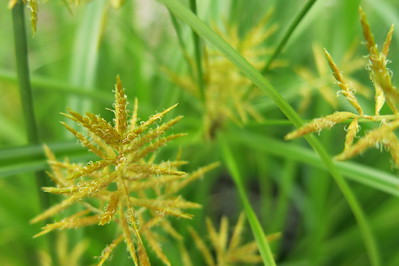Nutsedge can be one of the most challenging lawn weeds to manage. There are two primary classifications of nutsedge: yellow nutsedge and purple nutsedge. Yellow nutsedge is the more common form of the weed that folks in the New Jersey and Pennsylvania areas will deal with, and will be the primary focus of this article.
Nutsedge can spell trouble for a lot of lawn owners because of its aggressive growth and reproduction patterns. Its physical characteristics make it look a lot like regular grass, which can make it hard to identify in its early stages before it starts to spread and invade lawns. However, with proper identification and the correct control methods, nutsedge can be more effectively managed. In order to treat and control these difficult lawn weeds, it is important to first learn about what nutsedge really is, and how it functions.
How to Identify Nutsedge
Nutsedge, also commonly called nutgrass, is a grass-like weed in the sedge family. Yellow nutsedge is easily identified by its yellow to light green glossy leaves and the triangular shape of the stem. In contrast, the stems of regular turfgrass are more round. Nutsedge weeds form dense colonies and grow faster than turfgrass, becoming noticeable again just two to three days after mowing. If left untouched and allowed to grow tall enough, the weeds will begin to develop seedheads.
Nutsedge grows most actively during the warm spring and summer months. Yellow nutsedge thrives under warm, wet conditions and can often be found in low, damp areas of lawns. This weed will often peak during or after seasons with above normal amounts of rainfall. Nutsedge outbreaks often start in moist, poorly drained lawn areas, where they quickly develop into large colonies. Their extensive root systems may reach up to four feet deep. Once established, these weeds can tolerate drought.
Nutsedge Growth
Nutsedges can spread and reproduce in many different ways. These weeds are able to spread via underground stems, known as rhizomes, which send up shoots that become new plants. The most prevailing way that nutsedge will reproduce is through underground tubers known as “nutlets”. If you were to uproot nutsedge you would find a tangled root system made up of these rhizomes and nutlets.
Nutsedge roots extend deep into the soil of your lawn or garden beds, reaching up to 14 inches down into the soil. Those depths protect nutlets from the effects of many common herbicides and cold winter weather that might otherwise kill them. When the perennial weed dies in fall, its rhizomes and tubers survive the winter and sprout new plants in spring. One yellow nutsedge plant can produce thousands of nutlets each year, which can each eventually produce nutsedge patches several feet wide.
Tips For Treatment
With so much time and effort put forth towards caring for our lawns, we are going to do whatever it takes to keep them looking their best. Nutsedges are a problem in lawns because they grow faster, have a more upright growth habit, and are a lighter green color than most grass species, causing the turf to look non-uniform.
Now that we have a better idea of how it operates, there are some steps that can be taken in an effort to control nutsedge in your lawn. The best approach for avoiding Nutsedge problems is to prevent establishment of the weed in the first place. With a more clear picture of what nutsedge looks like, you might be able to identify the plant in its early stages before they start to develop tubers. This can help prevent the weeds from becoming established and able to spread in the first place.
Eliminating oversaturated conditions that favor nutsedge growth can also help as well. Take steps to correct low-lying, poorly drained areas and avoid overwatering. By practicing good lawn care basics, you can protect against nutsedge invasions and give your grass an advantage over these aggressive weed pests. Healthy, vigorous grass is also an excellent defense against yellow nutsedge.
Seek the Professionals
Perhaps you already are dealing with a nutsedge invasion and are looking to use a chemical treatment on your lawn. Pre-emergent herbicides are effective in eliminating plants that have not developed tubers. Unfortunately this herbicide may be detrimental to turf grass. Post-emergent selective herbicide applied at the appropriate time of the plant's life cycle can be an effective means of elimination, but again this herbicide may be detrimental to turf grass.
Effective treatment and control of nutsedge calls for products designed to overcome the unique challenges of these difficult weeds. This is where a professional lawn care service can step in and provide assistance. At Blue Grass Lawn Service, we use a product specifically designed for this issue, and can work with you to develop a plan to keep nutsedge away from your lawn for good.
Check out our Facebook page for more lawn care tips!
Featured Image: "Yellow Nutsedge," by NY State IPM Program at Cornell University, licensed under CC BY 2.0.
